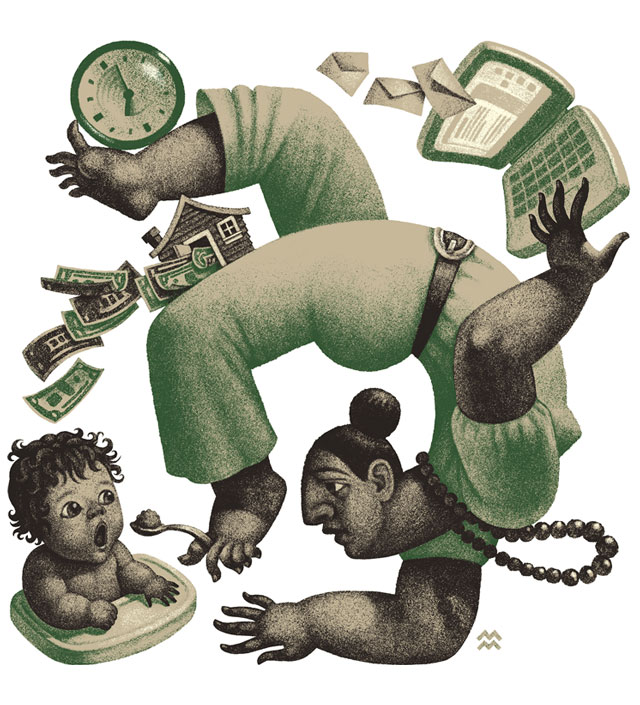Tara Driver would love to retire before age 70. But it’s not going to be easy.
The 51-year-old’s finances are still recovering from the hit they took more than a decade ago, after she spent about eight years caring for her ailing father.
During that time, every extra dollar went to pay for supplies and care for him, a veteran who died after a series of strokes and other complications. When she lost her job as an academic adviser because her employer shut down, Driver had to pull money she’d amassed in a 401(k) from two jobs before, as a program manager for the YMCA, so she and her father could survive until she found more work. She also deferred payments on her student loans, forced to let the interest build up.
Under a federal law enacted 30 years ago, the Family and Medical Leave Act, a majority of American workers can take up to 12 weeks off work each year to care for a family member without fear of losing their job. But that leave isn’t paid. So some states are taking on the issue.
This year, Minnesota and Maine became the latest of 13 states, along with the District of Columbia, to offer paid caregiving leave. The programs cover all eligible workers and are financed either by workers alone, or workers and employers. Lawmakers have also recently introduced bills in Illinois, Michigan and Pennsylvania, among others.
“We’ve seen tremendous momentum and progress in the states,” said Dawn Huckelbridge, the director of Paid Leave for All, an advocacy organization. “Just in the last year, it’s incredible to see what’s happened.”
If she’d had paid leave, Driver said, she is sure she could have helped her father stay healthier longer. At the very least, she wouldn’t have had to take time off without pay just so he could go to an appointment. “I could have continued to maintain financially,” said Driver, who now works at Women Employed, a Chicago nonprofit, running programs that help women of color advance in the workplace.
When a family member or close friend falls ill, many Americans face a predicament: Can they provide adequate care for their loved ones while earning enough money to pay their own bills? It’s a juggle even with paid family leave laws, which still cover fewer than one-third of U.S. workers.
A 2018 report by the World Policy Analysis Center found that replacing at least 80% of a person’s wages was necessary to keep families out of poverty, and to help middle-class families continue to meet essential needs, like paying their rent or mortgage. New York and Rhode Island offer less than 70% wage replacement, while other states reduce reimbursements for people with higher incomes. In Colorado, for example, where paid leave begins in January, reimbursement for those earning at or below $710.58 a week is 90%. Reimbursement is 50% for those earning more than that wage, up to a weekly maximum of $1,100.
Paid family leave “is not a silver bullet,” said Jason Resendez, the president and CEO of the National Alliance for Caregiving, a nonprofit advocacy group, “but it is one of the additional missing elements in the toolbox to help families better balance caring work and stay in the workforce and provide economically for their families.”
Leave programs, however, can drag workers and employers alike into a sticky web of government red tape and regulation, said Rachel Greszler, a research fellow at the Heritage Foundation, a conservative public policy organization. In Washington, D.C., for example, where her husband works, some employers forbid their employees from even answering an email when they are taking paid family leave, so they don’t violate the district’s strict rules, she said. And the nation’s patchwork quilt of state policies means large employers can find themselves parsing contradictory policies across state lines, she said.
“Employers are probably best able to provide flexible and accommodating policies,” she said. “And they’re best able to do that if there’s not all these rules and regulations placed on them.”
Depending on the state, paid family leave policies cover 60% to 100% of a paycheck up to a predetermined cap, for six to 12 weeks. (In New York state, for example, the maximum weekly benefit is $1,131.08.) In most states, the leave can be taken all at once or in increments.
The first state to offer paid leave was California, in 2004, building on the federal Family and Medical Leave Act, which was then 11 years old. The federal law guarantees most American workers job-protected, unpaid leave for up to 12 weeks to bond with a newborn baby or to care for a family member. But it excludes the 44% of employees whose work site employs fewer than 50 workers within 75 miles, or who work less than an average of 24 hours per week, or who haven’t worked for their current employer for at least 12 months. (Those months don’t have to be consecutive.) Under the federal law, leave is also limited to care of a child, spouse or parent.
As states add paid leave laws, they’re expanding worker eligibility. In Oregon, which began offering its residents paid leave this month, workers must have earned at least $1,000 in a year to qualify and can take up to 12 weeks of paid leave annually to care for either a family member or chosen family, meaning anyone whom the worker considers a family member. Like most states that offer paid leave, Oregon doesn’t automatically cover self-employed workers but allows them to opt in to the program, which they can do by making quarterly income-based contributions. The maximum weekly benefit is $1,523.63.
Every extra dollar is helpful because “caregiving is expensive,” said Vicki Shabo, a senior fellow for paid leave policy and strategy at New America, a left-leaning policy group. Caregivers spend, on average, about $7,200 annually on caregiving, and those expenses — for items such as special food for an ill person, health supplements or parking at a hospital — eat up 26% of caregivers’ incomes, according to a 2021 AARP survey.
“Having access to paid leave means being able at least to afford the basics,” Shabo said.
In states that have paid leave, one challenge is informing workers, particularly low-wage workers, that the leave programs exist, said Jenya Cassidy, director of the California Work and Family Coalition.
“People either have never heard of it or assume it’s not for them,” Cassidy said.
Her organization recently held an informational roundtable, she said, where some participants described themselves providing care for others but didn’t identify as caregivers. “They said, I’m just a daughter, a mother, fill in the blank,” Cassidy recalled. “It’s such an invisible thing in our culture, the role of being an unpaid caregiver.”
Caregivers of adults tend to be older themselves — more than half are at least 50 — and 6 out of 10 are women, according to a 2020 AARP survey. They are more likely than non-caregivers to have less than $1,000 in savings and investments, and, when they retire early, are more likely to cite caregiving as a reason (rather than being able to afford to leave work), according to a 2023 report from the Employee Benefit Research Institute.
Even with paid leave, caregiving can be financially draining. In 2017, Casie Fariello cut back on her work as a flight attendant to care for her three teenage children, who were then all experiencing mental health issues. She received paid leave from New Jersey, but it wasn’t enough. She and her husband drained their savings and borrowed from her 401(k). When she injured her back and ran out of time off, she left the job, her finances decimated.
“Am I going to have to be working until I’m 80 to be able to retire?” said Fariello, 54, of Hampton, New Jersey, who has since started a site called Other Parents Like Me, an online support community for parents of children in crisis. “You feel like you’re on a hamster wheel, like, ‘How am I going to catch up?’”
Even the most generous of policies cover a fraction of the year.
“If I had a magic wand?” said Resendez, from the National Alliance for Caregiving. “Right now, we’re talking and fighting for a 12-week paid leave policy. Right now, that’s the holy grail.” In a perfect world, he said, caregivers across the country would have flexibility.
If there were to be a national paid leave law, said Greszler, the research fellow at the Heritage Foundation, it should be minimal, around six weeks of leave per year, and employers that already offer at least that much should be allowed an exemption. Another option would be for the federal government to establish a universal savings account that people could use for any purpose, whether paid leave, child care or emergencies, she said.
Studies show that paid leave seems most successful when paired with job protection, according to findings by Kanika Arora, an associate professor at the University of Iowa, and Douglas Wolf, a professor emeritus at Syracuse University. A paper they’ve written, yet to be published, shows that paid leave encourages more informal caregiving only when that leave provides robust job protection beyond what’s available in the federal law, Arora said.
“The job protection thing is a big deal,” she said. If the job isn’t guaranteed to be there upon return, an eligible worker “might not want to take the leap.”
Eligibility, however, varies widely, state to state. For example: In Massachusetts, the state’s benefit of 12 weeks’ paid leave with job protection is available only to workers who earned at least $6,000 total over the past four calendar quarters. In Rhode Island, that same worker would have to make at least $15,600 (although there are alternative formulas) to be eligible for six weeks of job-protected paid leave. In Ohio, as in 36 other states, there is no paid caregiving leave.
“It shouldn’t be this complicated,” Shabo said. “The big meta here is everybody in this country should have access. That is the aspiration and the goal. That is why we need a federal program that covers everyone.”
c.2023 The New York Times Company. This article originally appeared in The New York Times.







